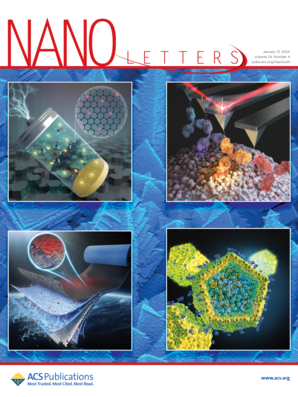La Doping LiNiO2 Cathode to Immobilize the Lattice Oxygen for Highly Stable Lithium-Ion Batteries
IF 9.6
1区 材料科学
Q1 CHEMISTRY, MULTIDISCIPLINARY
引用次数: 0
Abstract
LiNiO2 (LNO) with a high theoretical capacity and entirely free of cobalt has aroused much attention as a promising cathode material for lithium-ion batteries (LIBs). The rapid capacity decay, however, obstructs its commercialization. We first propose a strategy of La lattice-doping in the LNO (La-LNO) as a high-stability cathode for LIBs. Density-functional theory calculations suggest that the La dopant occupies the Ni-sites to stabilize the lattice oxygen due to a strengthening of the transition metal–oxygen bonds and mitigation of the charge compensation. La lattice-doped LNO cathode materials were fabricated successfully and had a specific capacity of 159.6 mAh g–1 after 100 cycles at 1 C with a capacity retention of 94.2% and a voltage retention of 99.9%. Atomic characterization reveals that La-LNO effectively inhibits the oxygen release and phase transformation during the cycling process. Our strategy provides leading guidance for designing practical high-performance LNO cathode materials for advanced LIBs.

La掺杂LiNiO2阴极固定化高稳定锂离子电池晶格氧
LiNiO2 (LNO)作为一种极具发展前景的锂离子电池正极材料,具有较高的理论容量和完全不含钴的特点,受到了广泛的关注。然而,容量的快速衰减阻碍了其商业化。我们首先提出了一种在LNO中掺杂La晶格的策略(La-LNO)作为锂离子电池的高稳定性阴极。密度泛函理论计算表明,由于过渡金属-氧键的增强和电荷补偿的减弱,La掺杂剂占据了ni位点以稳定晶格氧。成功制备了掺杂La晶格的LNO正极材料,在1℃下循环100次后,其比容量为159.6 mAh g-1,容量保持率为94.2%,电压保持率为99.9%。原子表征表明,La-LNO能有效抑制循环过程中的氧释放和相变。我们的策略为设计实用的高性能锂离子电池正极材料提供了指导。
本文章由计算机程序翻译,如有差异,请以英文原文为准。
求助全文
约1分钟内获得全文
求助全文
来源期刊

Nano Letters
工程技术-材料科学:综合
CiteScore
16.80
自引率
2.80%
发文量
1182
审稿时长
1.4 months
期刊介绍:
Nano Letters serves as a dynamic platform for promptly disseminating original results in fundamental, applied, and emerging research across all facets of nanoscience and nanotechnology. A pivotal criterion for inclusion within Nano Letters is the convergence of at least two different areas or disciplines, ensuring a rich interdisciplinary scope. The journal is dedicated to fostering exploration in diverse areas, including:
- Experimental and theoretical findings on physical, chemical, and biological phenomena at the nanoscale
- Synthesis, characterization, and processing of organic, inorganic, polymer, and hybrid nanomaterials through physical, chemical, and biological methodologies
- Modeling and simulation of synthetic, assembly, and interaction processes
- Realization of integrated nanostructures and nano-engineered devices exhibiting advanced performance
- Applications of nanoscale materials in living and environmental systems
Nano Letters is committed to advancing and showcasing groundbreaking research that intersects various domains, fostering innovation and collaboration in the ever-evolving field of nanoscience and nanotechnology.
 求助内容:
求助内容: 应助结果提醒方式:
应助结果提醒方式:


